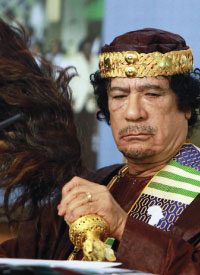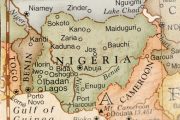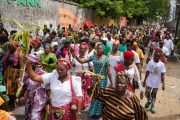
After seizing power, the budding despot promptly shut down Western military bases in Libya and set up “Revolutionary Committees” to quash opposition. While working to bring in his version of Arab socialism, Gadhafi also developed a massive system of informants to silence dissent. Critics were often publicly executed.
Using oil money instead of debt, Gadhafi’s regime did significantly raise Libyans’ standards of living — life expectancy and literacy rates surged. Blacks and women were also given equal “rights.” Many analysts cite the dictatorship’s socialist programs and robust welfare state as a reason he was able to cling to power for so long. Like most governments, Gadhafi ensured some level of popular support by using divide-and-conquer tactics and creating whole classes of citizens dependent on his regime’s largesse. Fear also played a key role.
A few years after the coup, Gadhafi began to dedicate more and more time to “revolutionary theorizing.” He eventually produced the “Green Book” outlining what he claimed was an Islamic form of “direct democracy” through local “People’s Congresses.” By the mid-1970s Gadhafi had relinquished all official titles to become simply “Brother Leader.” But in practice, his word was law — and he ruled with an iron fist.
Death by firing squad and torture were regularly meted out to dissenters. And opposition was all but prohibited. Political parties, for example, were completely banned as a form of “dictatorship.” The penalty for creating or joining one was often execution or worse. Beyond politics, certain minorities also became victims. Jews, for instance, were expelled from the country decades ago, and their property was seized by the regime. Berbers were also viciously persecuted.
Over four decades, Gadhafi’s maniacal rule claimed thousands of victims’ lives. The total may never be known. One of the worst alleged atrocities took place in 1996 at the Abu Salim prison, where, according to human rights groups, over a thousand prisoners were slaughtered.
But even overseas, exiled Libyan dissidents were not safe. Gadhafi’s assassins were known to use diplomatic cover to target enemies of the regime abroad. During an anti-regime protest at the Libyan embassy in London, the dictatorship’s “diplomats” even fired into the crowd, killing a British police officer.
Gadhafi also had a long history of supporting terrorists and communist murderers abroad using the vast oil wealth at his disposal. As Christian Gomez explained in a February online article for The New American entitled “Gadhafi’s Libya, Agent of the Soviet Menace,” Gadhafi’s Libya played a crucial role as an agent of Soviet menace. From the Sandinistas in Nicaragua and the Irish Republican Army to the Palestinian Liberation Organization and countless African revolutionary groups, the regime’s largesse played a key role in advancing world revolution.
Gadhafi provided arms, training, money, and more to a broad array of geopolitical players — especially those targeting the Free World. The regime in Tripoli also helped send Soviet weapons to countless ruthless dictators and aspiring communist rulers. And Gadhafi even sent his troops to support the mass-murdering Ugandan tyrant Idi Amin.
Speaking to Time magazine as Western rulers were heaping praises on the Libyan tyrant in 2006, Gadhafi said he had simply been doing the same thing Bush claimed to be doing when the United States invaded Iraq. “Bush is saying that America is fighting for the triumph of freedom,” the Libyan despot was quoted as saying. “When we were supporting liberation movements in the world, we were arguing that it was for the victory of freedom. We both agree. We were fighting for the cause of freedom.”
Before becoming a “Good Guy,” an “important ally,” and a “model,” however, Gadhafi and his brutal regime were ostracized by most Western rulers for decades. President Ronald Reagan even referred to the Libyan despot as a “mad dog” aiming to foment “world revolution.”
Open violence broke out by the mid 1980s. Gadhafi, claiming that Western governments were supporting Libyan rebels, sent weapons and aid to communist terror groups in Europe. And following a 1986 bombing in Berlin that was linked to the Libyan regime — one of many terror strikes tied to the despot — Reagan attacked. Gadhafi survived, but his regime suffered a serious blow. It took two decades for the two governments to become “friends” again.
Photo of Gadhafi: AP Images
This article is an example of the exclusive content that's only available by subscribing to our print magazine. Twice a month get in-depth features covering the political gamut: education, candidate profiles, immigration, healthcare, foreign policy, guns, etc. Digital options available! For more information, click here.
Related article:
Libya: Now What?



